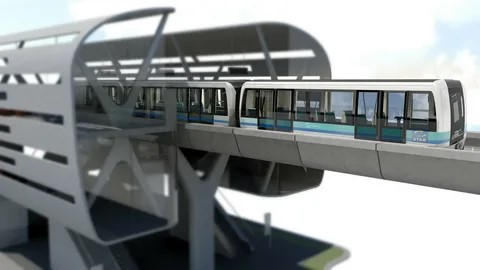
The upsurge in the number of people living in urban areas, improvement in transportation structure, and the need for transit systems that can operate on their own, will make APM market likely to witness significant growth in the coming year. The APM market is estimated to rise from USD 581.3 million in 2025 to USD 1,050.9 million by 2035, with a CAGR of 6.1% over the forecast period.
The global Automated People Mover (APM) Market is experiencing significant growth, driven by the increasing demand for efficient, automated transportation systems in urban areas, airports, and large-scale infrastructure projects. Governments and private entities are investing in smart mobility solutions to reduce congestion and enhance passenger convenience.
Get Ahead with Our Report: Request Your Sample Now!
https://www.futuremarketinsights.com/report-sample#5245502d47422d37313135
Key Takeaways:
- Rising adoption of automated transit solutions in airports, urban centers, and theme parks.
- Increasing investment in smart city infrastructure and sustainable transport.
- Advancements in AI, IoT, and automation are enhancing APM efficiency.
- North America and Asia-Pacific lead the market due to high airport traffic and urban expansion.
- Shift towards eco-friendly, electric-powered automated transit systems.
Key Drivers:
- Growing Demand for Airport Connectivity – Airports worldwide are implementing APMs to improve passenger movement and reduce travel time.
- Smart City and Urban Mobility Initiatives – Government policies promoting automated and efficient transport systems are fueling market growth.
- Advancements in Autonomous and Electric Transport Technologies – AI-driven automation and electric propulsion are making APMs more efficient and sustainable.
- Increasing Public-Private Partnerships (PPP) – Collaborations between governments and private companies are accelerating APM deployment.
- Rising Urban Congestion and Need for Efficient Transit – Automated people movers provide seamless transit solutions in high-density areas.
Growth Opportunities:
- Expansion of APM networks in major airports and urban centers.
- Development of AI-powered APM control and monitoring systems.
- Integration of energy-efficient and electric APM solutions.
- Growing demand for APMs in theme parks, exhibition centers, and resort areas.
- Adoption of modular and scalable APM systems to enhance flexibility.
Challenges & Opportunities
Challenges
High Initial Investment Costs and Integration Complexities
The primary obstacle to the adoption of APMs is the initial capital outlay that is very high for the overall development, implementation, and upkeep of these systems. The infrastructure, technology, and integration with already existing transportation networks can considerably higher costs, which may impede a lot of cities and proper organizations.
Furthermore, the combining of APMs with the current transport modes and urban infrastructure involves not only technical engineering but also operational problems; this entails perfect coordination among the different systems in place that can drive both costs and timeframes up. This multifaceted issue can discourage possible investors and stakeholders from injecting capital into the APM solutions, especially in scarce resource areas.
Opportunities
AI-driven Automation Breakthroughs
AI-driven automation constitutes exciting growth opportunities for the APMs through the optimization of system efficiency, enhancement of safety, and assurance of reliability. AI-powered tools ease the burden on maintenance through the prediction of machinery ailments, decision-making in real-time, and route planning.
This, besides cutting operational costs, boosts user-experience. As AI develops further, APM structures will change into self-learning, intelligent systems and be able to deal with decision-making problems more efficiently thus increasing performance and the autonomy level of humans.
In addition, these AI-related developments will also help make the vision of a fully-autonomous APM Network come true where not only the infrastructure but also the manpower is dominant that means it is fully independent organizations can thus reduce the labor cost and at the same time increase the capability of the transportation systems. The continued growth of AI unlike the way for innovation in the APM field.
Detailed Market Study: Full Report and Analysis
https://www.futuremarketinsights.com/reports/automated-people-mover-market
Application Areas:
- Airports & Aviation Hubs
- Urban Transit & Smart Cities
- Theme Parks & Entertainment Centers
- Railway & Metro Station Connectivity
- Resort & Campus Transportation
Key Players:
- Bombardier Transportation
- Mitsubishi Heavy Industries
- Siemens Mobility
- Doppelmayr Seilbahnen GmbH
- Alstom
- POMA Group
- Hitachi Rail
- Thales Group
- Intamin Transportation
- Ansaldo STS
Market Segmentation:
- By System Type: Monorail, Cable-Propelled, Automated Guideway Transit
- By Technology: Driverless, Semi-Automated
- By Application: Airports, Urban Transit, Amusement Parks, Others
- By Region: North America, Europe, Asia-Pacific, Latin America, Middle East & Africa
About Future Market Insights (FMI)
Future Market Insights, Inc. (ESOMAR certified, recipient of the Stevie Award, and a member of the Greater New York Chamber of Commerce) offers profound insights into the driving factors that are boosting demand in the market. FMI stands as the leading global provider of market intelligence, advisory services, consulting, and events for the Packaging, Food and Beverage, Consumer Technology, Healthcare, Industrial, and Chemicals markets. With a vast team of 400 analysts worldwide, FMI provides global, regional, and local expertise on diverse domains and industry trends across more than 110 countries.
Contact Us:
Future Market Insights Inc.
Christiana Corporate, 200 Continental Drive,
Suite 401, Newark, Delaware – 19713, USA
T: +1-845-579-5705
For Sales Enquiries: sales@futuremarketinsights.com
Website: https://www.futuremarketinsights.com
LinkedIn| Twitter| Blogs | YouTube


